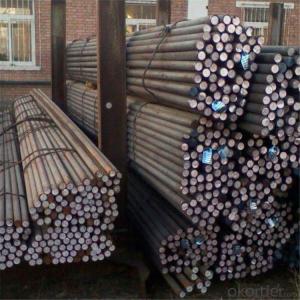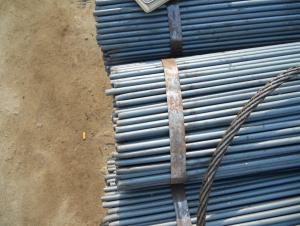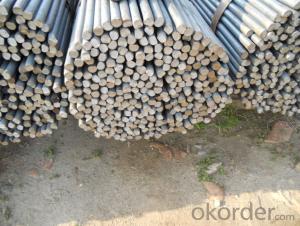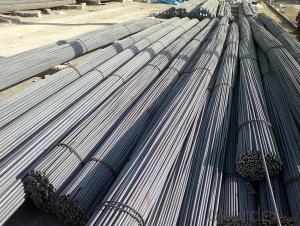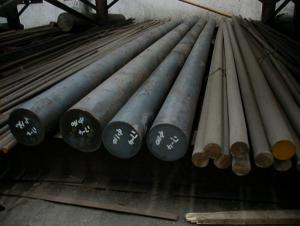SAE1045 C45 Cold Drawn Steel Round Bar
- Loading Port:
- Tianjin
- Payment Terms:
- TT OR LC
- Min Order Qty:
- 100 m.t.
- Supply Capability:
- 50000 m.t./month
OKorder Service Pledge
OKorder Financial Service
You Might Also Like
Item specifice
SAE1045 C45 Cold Drawn Steel Round Bar
Product Description of SAE1045 C45 Cold Drawn Steel Round Bar
1. Steel grade: SAE1045, 45#, C45, S45C
2. Length: 6M-12M
3. Diameter: 16mm-300mm
4. Product range: round bar, flat bar, square bar
5. Technique: Hot rolled, forged, cold drawn
Specification of SAE1045 C45 Cold Drawn Steel Round Bar
Material | SAE1045 | Round bar | Dia(mm) | 16-300mm |
Process | EAF + LF + VD + Forged + Heat Treatment (optional) | Length (mm) | Max 12m | |
Heat treatment | Normalized / Annealed / Quenched / tempered | Flat bar | Thickness(mm) | 8-500mm |
Delivery condition | Hot forged +Rough machined (black surface after Q/T)+ Turned (optional) | Width(mm) | 70-200mm | |
Test | Ultrasonic test according to SEP 1921-84 D/d | Length (mm) | Max 12m |
Chemical Composition of SAE1045 C45 Cold Drawn Steel Round Bar
C | Si | Mn | Cr | Ni | Cu |
0.42~0.47 | 0.17~0.37 | 0.35~0.65 | ≤0.25 | ≤0.30 | ≤0.25 |
Photo Show of SAE1045 C45 Cold Drawn Steel Round Bar
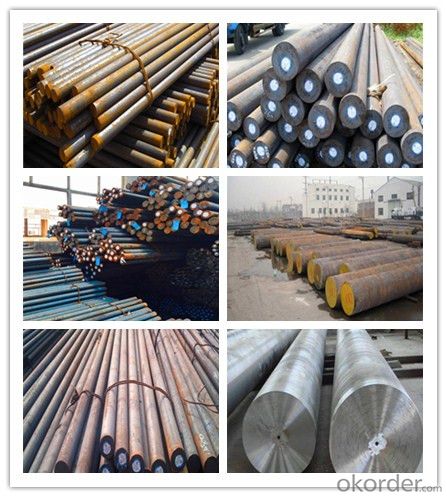
Packing and Delivery:
Packing in bundle package, or as customer's requirements.
Delivery Detail: 45 days after receiving the deposit.
Usage and Applications of SAE1045 C45 Cold Drawn Steel Round Bar
1. Steel round bar is used in a large number of architectural and engineering structures. Or it can be used in construction of plants for the production of steel house frames, high-voltage transmission towers, bridges, vehicles, boilers, containers, ships, etc.
2. And we can use this kind of product on the performance of the mechanical parts if the demand is not very high.
3. Some special material steel round bar can be used for main shaft of steamer, hummer shank, with big section and supper force.
Company Information
CNBM International Corporation is the most important trading platform of CNBM group.
Whith its advantages, CNBM International are mainly concentrate on Cement, Glass, Iron and Steel, Ceramics industries and devotes herself for supplying high qulity series of refractories as well as technical consultancies and logistics solutions.


F A Q
1, Your advantages?
professional products inquiry, products knowledge train (for agents), smooth goods delivery, excellent customer solution proposale
2, Test & Certificate?
SGS test is available, customer inspection before shipping is welcome, third party inspection is no problem
3, Factory or Trading Company?
CNBM is a trading company but we have so many protocol factories and CNBM works as a trading department of these factories. Also CNBM is the holding company of many factories.
4, Payment Terms?
30% TT as deposit and 70% before delivery.
Irrevocable L/C at sight.
5, Trading Terms?
EXW, FOB, CIF, FFR, CNF
6, After-sale Service?
CNBM provides the services and support you need for every step of our cooperation. We're the business partner you can trust.
For any problem, please kindly contact us at any your convenient time.
We'll reply you in our first priority within 24 hours.
- Q:Can steel round bars be used for making power transmission systems?
- Yes, steel round bars can be used for making power transmission systems. Steel round bars are commonly used in various industries for their high strength and durability. They are suitable for power transmission systems due to their ability to withstand high torque and load capacities. Steel round bars can be machined and formed into various shapes and sizes, making them versatile for different power transmission applications. Additionally, steel has excellent wear resistance and can withstand harsh operating conditions, making it an ideal material for power transmission systems that require long-lasting performance.
- Q:Can steel round bars be used in the oilfield equipment industry?
- Yes, steel round bars can be used in the oilfield equipment industry. Steel round bars are commonly used in the manufacturing of various components and structures in the oilfield equipment industry due to their strength, durability, and resistance to corrosion. These bars are often utilized in the construction of drilling tools, pipe fittings, valves, and other equipment needed for oil exploration, extraction, and transportation.
- Q:Can steel round bars be used in the production of springs?
- Certainly! Springs can be produced using steel round bars. Steel is a commonly chosen material for manufacturing springs because it possesses strong attributes and excellent durability. Steel round bars are frequently employed as the foundation material for springs because they can be easily manipulated and formed into the desired spring shape. Moreover, by subjecting steel round bars to heat treatment, their mechanical properties can be improved, rendering them appropriate for a range of spring applications. The selection of steel type relies on the desired characteristics and requirements of the spring, such as the desired level of flexibility and resistance to deformation. In summary, steel round bars are extensively employed in spring production due to their outstanding mechanical properties, making them a suitable option for a variety of spring applications.
- Q:What are the different surface treatments available for stainless steel round bars?
- To enhance the appearance, improve corrosion resistance, and provide added protection for stainless steel round bars, there are various surface treatments available. Some commonly used surface treatments for stainless steel round bars are as follows: 1. Acid immersion: This process involves immersing the stainless steel bar in an acid solution to eliminate surface impurities and oxides. Acid immersion restores the natural corrosion resistance of stainless steel and results in a smooth and clean surface. 2. Chemical passivation: Passivation is a chemical treatment that forms a thin, protective layer on the surface of stainless steel. By eliminating free iron and other contaminants, passivation enhances the corrosion resistance of stainless steel. 3. Electrolytic polishing: This treatment involves immersing the stainless steel round bar in an electrolyte solution and applying an electric current. By removing a thin layer of material from the surface, electrolytic polishing creates a smooth, shiny, and corrosion-resistant finish. 4. Mechanical grinding and polishing: Grinding and polishing are mechanical processes used to improve the surface finish of stainless steel round bars. Grinding eliminates imperfections and roughness, while polishing creates a smooth and reflective surface. 5. Protective coating: Applying a protective layer to stainless steel round bars can provide additional corrosion resistance. Common coatings include electroplating with zinc or nickel, as well as organic coatings such as paints or powder coatings. 6. High-velocity shot blasting: This treatment involves bombarding the surface of the stainless steel round bar with small metallic or non-metallic particles at high speed. Shot blasting eliminates surface contaminants, scales, or oxides, resulting in a clean and textured surface. It is important to consider the desired end-use application and specific requirements for appearance and corrosion resistance when choosing a surface treatment for stainless steel round bars. Seeking advice from professionals or manufacturers can help determine the most suitable treatment.
- Q:What is the typical hardness of a steel round bar?
- The typical hardness of a steel round bar can vary depending on the specific grade and heat treatment it has undergone. However, in general, steel round bars have a hardness ranging from 100 to 300 on the Brinell hardness scale. This scale measures the resistance of a material to indentation and is commonly used to assess the hardness of metals. It is important to note that different applications may require different levels of hardness, and steel round bars can be customized to meet specific requirements through various heat treatment processes such as quenching and tempering.
- Q:Can steel round bars be used for making conveyor belts or rollers?
- No, steel round bars are not typically used for making conveyor belts or rollers. Conveyor belts and rollers are usually made from materials such as rubber, polyurethane, or other flexible and durable materials that can withstand the constant movement and friction involved in conveying items.
- Q:What are the different types of steel round bar coatings used in the marine industry?
- In the marine industry, various coatings are commonly used to protect steel round bars from corrosion and other environmental factors. These coatings have been specifically designed to withstand the harsh conditions found in marine environments. The most frequently utilized types of coatings in this industry include the following: 1. Galvanized Coating: A layer of zinc is applied to galvanized steel round bars, offering excellent corrosion protection and durability. This coating is ideal for marine applications where the steel is exposed to corrosive elements such as saltwater. 2. Epoxy Coating: Due to their exceptional resistance to corrosion and strong adhesion properties, epoxy coatings are widely employed in the marine industry. Multiple layers of epoxy are typically applied to ensure optimal protection against saltwater, chemicals, and abrasion. 3. Polyurethane Coating: Polyurethane coatings are highly regarded for their exceptional resistance to UV rays, chemicals, and abrasion. These coatings provide a high level of corrosion protection in marine environments, making them ideal for offshore structures and marine equipment that require long-term durability. 4. Organic Coatings: Acrylics and vinyls are commonly used in the marine industry as organic coatings, offering a protective barrier against corrosion and environmental factors. These coatings are known for their flexibility, ease of application, and resistance to UV radiation. They are often utilized in marine applications where aesthetics and color retention are important. 5. Ceramic Coating: Ceramic coatings are particularly resistant to high temperatures, chemicals, and abrasion. They form a hard, protective layer on steel round bars, making them suitable for marine applications that involve extreme heat and harsh environments. When selecting the appropriate steel round bar coating for a marine project, it is essential to consider the specific requirements of the application. Factors such as the type of exposure, expected service life, and budget should be taken into account to determine the most suitable coating.
- Q:Excuse me, the difference between round steel, screw steel, steel, plate material, steel wire, hope professional answer
- Disk and rebar with rib, have all the same, basically can not see, rebar size is more than Phi 9, a lot of hardness than wire reinforced strong general, so the steel strip is usually linear, bluntly, steel disc is not up, disc. The size can be intercepted, so can be screwed up disc.
- Q:What are the different types of surface defects in steel round bars?
- There are several different types of surface defects that can occur in steel round bars. These defects can vary in severity and can impact the quality and performance of the bars. Some of the common types of surface defects in steel round bars include: 1. Scale: Scale is a type of oxide layer that forms on the surface of steel during the manufacturing process. It can appear as a rough, flaky layer on the surface of the bar. Scale can negatively affect the appearance and surface finish of the bar. 2. Pits: Pits are small depressions or cavities that can occur on the surface of the bar. They can be caused by various factors such as corrosion, mechanical damage, or manufacturing defects. Pits can weaken the structural integrity of the bar and make it more susceptible to failure. 3. Scratches: Scratches are shallow grooves or marks on the surface of the bar. They can be caused by handling, transportation, or contact with other objects during the manufacturing process. While scratches may not significantly impact the strength of the bar, they can affect its appearance and surface finish. 4. Cracks: Cracks are linear fractures that can occur on the surface of the bar. They can be caused by excessive stress, thermal cycling, or manufacturing defects. Cracks can be extremely detrimental to the strength and integrity of the bar and can lead to catastrophic failure if left untreated. 5. Decarburization: Decarburization refers to the loss of carbon from the surface layer of the steel bar. It can occur during the heating or cooling processes and can result in a softer and weaker surface layer. Decarburization can reduce the overall strength and durability of the bar. 6. Lamination: Lamination refers to the separation or delamination of layers within the steel bar. It can occur during the manufacturing process due to improper bonding or rolling conditions. Lamination can weaken the structural integrity of the bar and make it more prone to failure. 7. Inclusions: Inclusions are non-metallic particles or impurities that can be present on the surface of the bar. They can be caused by contaminants in the raw materials or improper manufacturing processes. Inclusions can negatively impact the mechanical properties and performance of the bar. It is important to identify and address these surface defects in steel round bars to ensure their quality and performance. Various inspection and testing methods can be employed to detect and mitigate these defects, such as visual inspection, ultrasonic testing, magnetic particle inspection, and dye penetrant inspection.
- Q:How do steel round bars differ from steel square bars?
- Steel round bars and steel square bars differ in their shape and appearance. Steel round bars, as the name suggests, have a circular cross-section and are cylindrical in shape. This shape makes them ideal for applications that require strength and stability, such as construction, manufacturing, and engineering. The circular shape allows for equal distribution of stress and load, making round bars highly resistant to bending or twisting forces. They are commonly used as structural components in buildings, support beams, shafts, and axles. On the other hand, steel square bars have a square cross-section with four equal sides and sharp corners. This shape provides additional benefits in certain applications. Square bars offer better grip and handling, as they have flat surfaces, making them easier to hold, stack, or secure in place during fabrication or installation. They are often used for manufacturing machinery, tools, frames, and brackets where square edges are needed for precise alignment or stability. Both steel round bars and steel square bars are available in various grades and alloys, offering different levels of strength, hardness, and corrosion resistance. The choice between the two depends on the specific requirements of the project or application.
1. Manufacturer Overview |
|
|---|---|
| Location | |
| Year Established | |
| Annual Output Value | |
| Main Markets | |
| Company Certifications | |
2. Manufacturer Certificates |
|
|---|---|
| a) Certification Name | |
| Range | |
| Reference | |
| Validity Period | |
3. Manufacturer Capability |
|
|---|---|
| a)Trade Capacity | |
| Nearest Port | |
| Export Percentage | |
| No.of Employees in Trade Department | |
| Language Spoken: | |
| b)Factory Information | |
| Factory Size: | |
| No. of Production Lines | |
| Contract Manufacturing | |
| Product Price Range | |
Send your message to us
SAE1045 C45 Cold Drawn Steel Round Bar
- Loading Port:
- Tianjin
- Payment Terms:
- TT OR LC
- Min Order Qty:
- 100 m.t.
- Supply Capability:
- 50000 m.t./month
OKorder Service Pledge
OKorder Financial Service
Similar products
New products
Hot products
Related keywords
